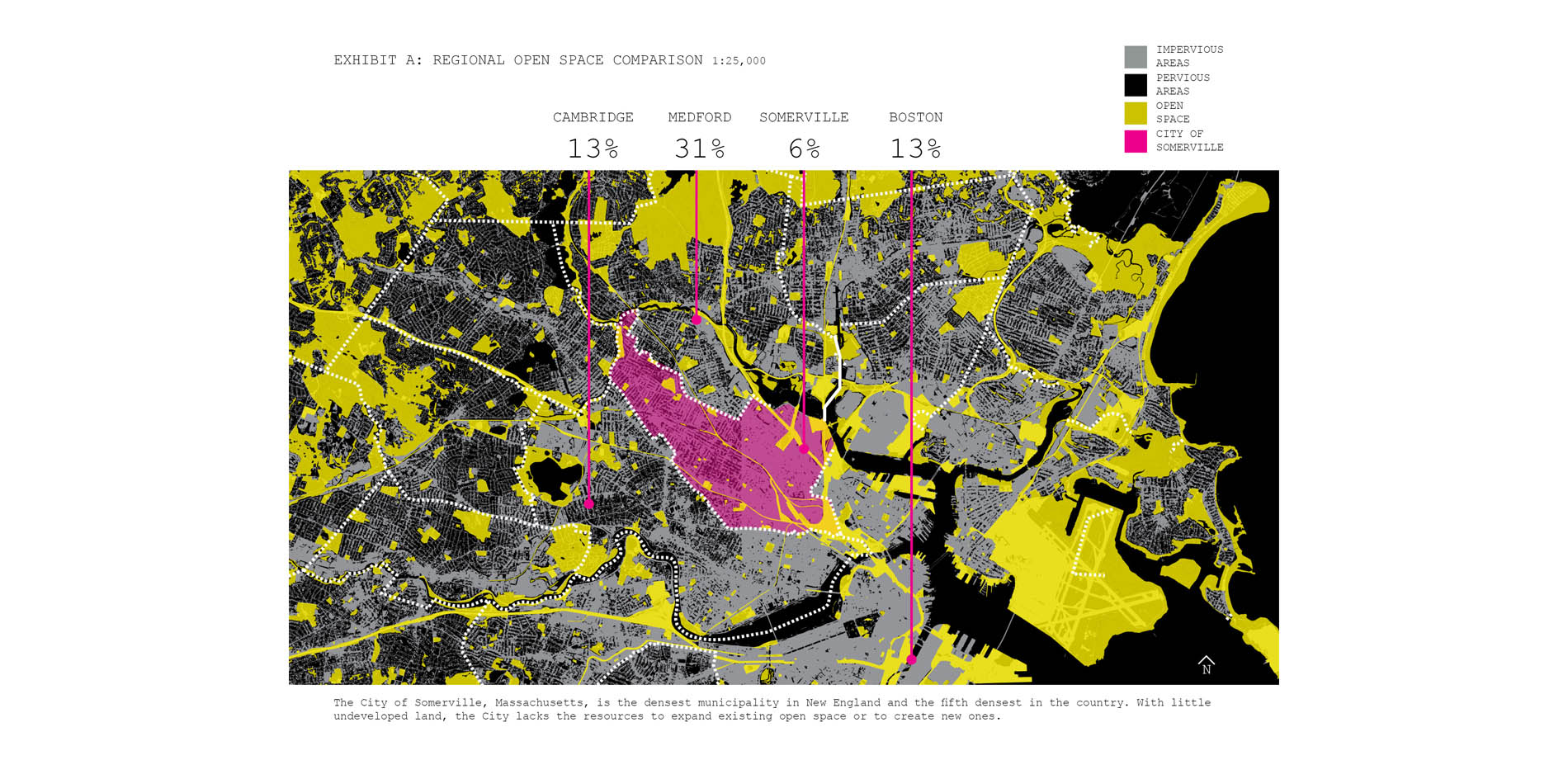
Exhibit A: Regional Open Space Comparison. The City of Somerville, Massachusetts, is the densest municipality in New England and the fifth densest in the country. With little undeveloped land, the City lacks the resources to expand existing open space or to create new ones.
Photo Credit: Cali Pfaff
Media: Please submit high-resolution image requests to images@asla.org.
Exhibit B: Ecological Analysis. The City’s standard maintenance procedures aim to promote ‘health & safety.’ On the ground, however, these policies lead to a landscape that lacks both ecological and programmatic diversity, sacrificing systems health for personal.
Photo Credit: Cali Pfaff
Media: Please submit high-resolution image requests to images@asla.org.
Exhibit C: Pollinator Decline. Worldwide, pollinator species, responsible for 30% of our food system, are in a state of collapse. Nevertheless, honey bees show promise for the urban survival of pollinators, with larger honey yields and more overwintering success in cities.
Photo Credit: Cali Pfaff
Media: Please submit high-resolution image requests to images@asla.org.
PROPOSAL A: MUNICIPAL MAINTENANCE MAP 1:15,000. Counterordinance looks to retool 3 key maintenance practices along the largest contiguous piece of vacant land left in Somerville (the rail corridor) in order to support dwindling pollinator populations and to expand open space options.
Photo Credit: Cali Pfaff
Media: Please submit high-resolution image requests to images@asla.org.
PROPOSAL B: PLANTING PALETTES. Color acts as a signifier of intentionality, making visible how the land is managed. A yellow field indicates an alternative to mowing, a purple meadow, and the result of snow removal, and pink corridors as erosion control and habitat management.
Photo Credit: Cali Pfaff
Media: Please submit high-resolution image requests to images@asla.org.
SNOW REMOVAL: DIRECTIVE. To increase snow removing capacity, to streamline the snow removal cycle, to recycle road salt, leaf litter and runoff to create brakish meadows, and to desalinate snowmelt before it hits the Mystic River.
Photo Credit: Cali Pfaff
Media: Please submit high-resolution image requests to images@asla.org.
SNOW REMOVAL, PRO. 1: REDIRECT SNOWMOBILES. When street plows reach capacity for on street storage, half of the snow will be collected and taken to the snow meadows. Snow will be dumped per the dumping sequence diagram (Fig. C).
Photo Credit: Cali Pfaff
Media: Please submit high-resolution image requests to images@asla.org.
SNOW REMOVAL PROC. 2: LOWER SALINITY. Once piled, snow farm will be regularly flooded with stormwater to expedite snowmelt. The snow farm will be flooded to primary capacity the first week of March with the addition of gypsum to lower salinity and support plant life.
Photo Credit: Cali Pfaff
Media: Please submit high-resolution image requests to images@asla.org.
SNOW REMOVAL PROC. 3: SEED SNOW MEADOWS. Snow meadows will be flooded to disperse salt tolerant seed mix #3 or #4. Municipal leaf litter will be deposited once a week in the flood zone from August to November. Snow meadows are publicly accessible in summer and lot is used to store off-season trucks.
Photo Credit: Cali Pfaff
Media: Please submit high-resolution image requests to images@asla.org.
OVERGROWTH MGMT: DIRECTIVE. To reduce the amount of mowing on municipal properties, so create wildlife habitat for meadowland species and short-tongued bees, to expand open space options, and to make the work of DPW and the pollinators legible in the land.
Photo Credit: Cali Pfaff
Media: Please submit high-resolution image requests to images@asla.org.
OVERGROWTH MGMT PROC. 1: REDIRECT WORKFORCE. For management purposes, open fields will be divided in thirds at the discretion of the supervisor. One third will be mowed regularly, one third left unmaintained, and one third tilled in spring and seeded with municipal seed mixture #1 or #2, alternating annually.
Photo Credit: Cali Pfaff
Media: Please submit high-resolution image requests to images@asla.org.
OVERGRWOTH MGMT PROC. 2: PLAN FOR SUCCESSION. Each fall and spring, crew will check fields for caterpillar host plants. Host plants exceeding 2ft in height will be flagged. Mowers will not mow within prescribed radius from host plants. Informal moved pathways will allow public access throughout.
Photo Credit: Cali Pfaff
Media: Please submit high-resolution image requests to images@asla.org.
WILDLIFE MGMT: DIRECTIVE. To stabilize slopes along the rail corridor, to provide inaccessible habitat for long-tongued bees, to beautify the corridor, and to expand existing habitat.
Photo Credit: Cali Pfaff
Media: Please submit high-resolution image requests to images@asla.org.
WILDLIFE MGMT PROC. 1: REDESIGN WALL SYSTEM. In areas where the train corridor is significantly (2m+) above or below grade, existing retaining walls shall be replaced with the modified habitat wall system (Fig. A), designed to suit the nesting habits of species of long tongued bees.
Photo Credit: Cali Pfaff
Media: Please submit high-resolution image requests to images@asla.org.
Wild MGMT PROC. 2: STEWARD THE CORRIDOR. Designated habitat areas are closed to public access but will be viewable from the community path trail and train. A patterning of flora will be evident from the train. The blooms actively remind passengers of the possibilities in stewarding urban wilds.
Photo Credit: Cali Pfaff
Media: Please submit high-resolution image requests to images@asla.org.


















